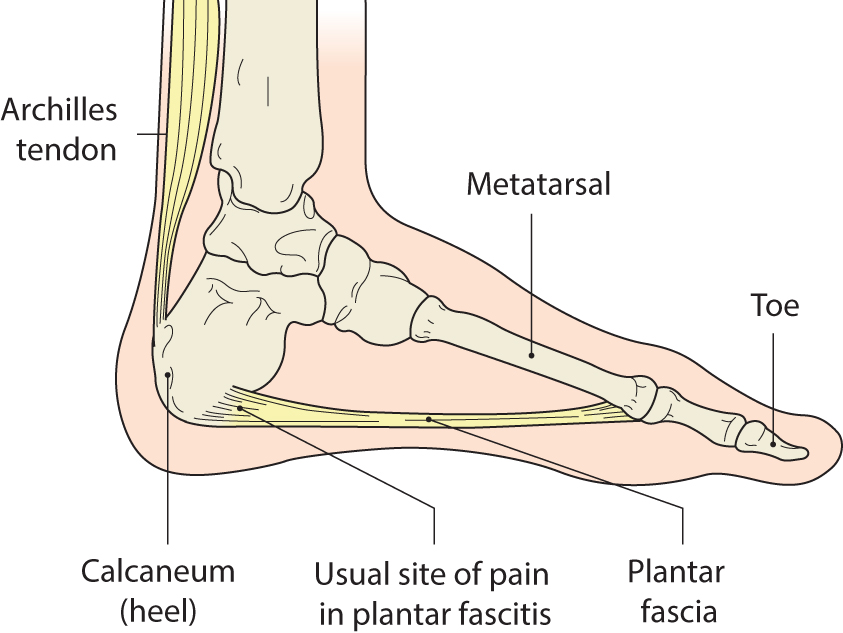FOOT PROBLEMS Pain or discomfort may occur anywhere in the foot, and there are several common presenting conditions Achilles tendinitis Inflammation, irritation, and swelling of the Achilles tendon; puts the tendon at greater risk of tearing or rupture. Athlete’s foot (tinea pedis) Common fungal infection. Skin between the toes is itchy and macerated. More common in young males. Risk factors are swimming, occlusive footwear, hot weather. May also be associated with groin and nail infection.
A spur in the heel that can accompany plantar fasciitis (see below). Not generally painful. If fasciitis is treated properly, bone spur does not cause a problem.
A protective bursa over the metatarsal head where the shoe rubs. May become inflamed and infected. Often caused by frequent wearing of shoes too narrow at the toe.
A hardened and thickened area of skin resulting from constant pressure, friction or trauma. Not necessarily painful.
Localised inflammatory lesions of the extremities, generally bilateral and symmetrical. Often occur in crops in the winter months. Red and itchy, with a burning sensation; painful on warming, and occasionally oedematous; can become deep purple or reddish-purple. Usually self-limiting.
A thickened area of skin caused by pressure or friction. A core of hard keratin is surrounded by an opalescent margin. Generally is painful and requires treatment.
The term ‘foot attack’ is used to describe an injury to a foot or feet of someone with diabetes who has reduced feeling or reduced blood circulation in their feet. The foot may be red, warm or swollen; there may be a break or breaks in the skin, with or without discharge. Patients may also feel unwell (suggesting systemic infection). A foot attack is a medical emergency that needs immediate attention. Practice Nurse featured article Foot attack and what patients should do if it happens Barbara Young, Diabetes UK
Acute condition that causes joint pain. Occurs when blood uric acid concentration is high (>600 micromol/l). Symptoms develop suddenly, often in only one or a few joints; great toe, knee and ankle are often affected. Joint may look shiny or glossy, warm and reddened (i.e. looks infected), with throbbing, excruciating pain. More likely in males, postmenopausal women, and following consumption of alcohol and/or purine-rich foods, e.g. offal, oily fish.
A deformity, usually in one toe, at the proximal interphalangeal joint, whereby the toe curls downwards into a claw-like position. Initially flexible, but once longstanding becomes more rigid. Often noticed when a corn appears on the top of the toe.
Generally mild illness affecting mostly children under 10 years; usually clears within 1 week. Caused by the coxsackie A virus or sometimes coxsackie B and enterovirus 71. Very occasionally meningoencephalitis or myocarditis may occur. Some evidence that may rarely be harmful in pregnancy. Presents with raised temperature, sore throat, and spots in the mouth that turn to ulcers, then spots on hands and feet, occasionally buttocks, legs and genitals. Good hygiene measures reduce spread of virus.
Inflammation at back of heel, caused by landing awkwardly or by pressure from shoes.
Most commonly caused by excessive or repetitive heel pounding. The heel bone (calcaneus) is protected by a pad of fat that repeated pounding can cause to be pushed up the side of the heel, leaving less of a protective layer.
Some feet have a higher arch than normal, with the heel often tilted inwards at the ankle. Toes may appear clawed, occasionally causing pain. Corns and calluses may occur, shoes may be uncomfortable. Ankle sprain is more common.
Generally the large toe is affected, on one or both sides. The nail burrows into the nail groove, causing the groove to ulcerate; the wall then grows over the nail, which becomes embedded. Ingrowth may be caused by wearing tight shoes or socks. Infection may occur, causing the area to become warm, reddened, oedematous and very painful.
Presents with sharp, intermittent pain between the 3rd and 4th toes when wearing shoes. Results from thickening and swelling of tissue around a nearby nerve. Symptoms include progressive tingling, sharp shooting or burning pains in the ball of the foot and often the toes, when wearing shoes or applying pressure to the area. Seems more common in females, possibly from wearing constricting shoes. Fungal infection (tinea unguium) spreads from distal edge to involve whole nail, which eventually thickens, yellows and crumbles. More common in toenails than finger nails and with increasing age. Athlete’s foot (tinea pedis) often co-exists.
Inflammation of the plantar fascia, which is a thick band of connective tissue that stretches from the heel to the bones of the mid-foot, supporting the arch and acting as a shock absorber.
An injury to the ligaments around a joint, caused when a joint is forced to move into an unnatural position. A ligament tears if over-stretched, resulting in a painful and oedematous joint. Bruising is mild in a partial tear, severe in a completely torn ligament. Practice Nurse featured article Self care for minor ailments: Strains and sprains Dr Knut Schroeder and Sara Richards Verrucas (plantar warts) Warts (an infection of the epidermis with human papillomavirus, HPV), on the soles of the feet, occurring generally where skin has been cracked or broken. Similar to the common wart but pressed into the dermis by body weight, a verruca is a slightly raised, circular lesion with a thickened rim. Black dots (capillaries) give a pepper-pot appearance. May occur in groups and be painful; generally harmless and self limiting. To reduce risk of infecting others: do not share towels; do not go barefoot; when swimming, cover verrucas with waterproof plaster. |
|
 Foot attack
Foot attack